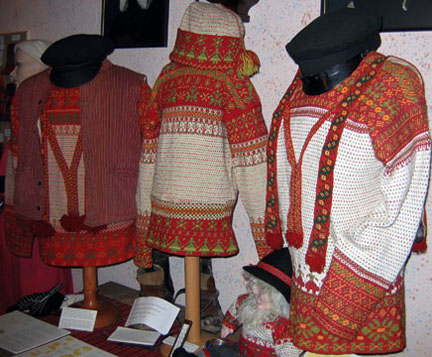
Men’s crocheted and knit sweaters, hat, and suspenders in the Korsnäs Museum.
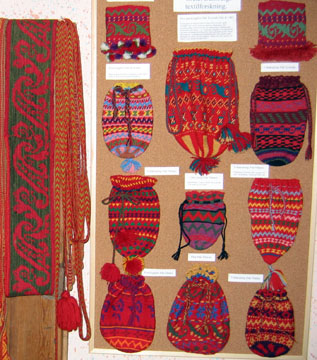
A wide tapestry crocheted sash, a narrow woven sash,
and tapestry crocheted cuffs and bags in the Korsnäs Museum.
Korsnäs sweaters are a stunning combination of tapestry crochet and knitting. Beginning at the bottom, they are crocheted, then knit, then crocheted in rounds for both pullover and open styles. The top seam is hand sewn together, the tube is secured with machine-sewn stitches around the arm openings, then the arm holes are cut. The sleeves are crocheted, then knit, then crocheted from the shoulder to the cuff and then sewn onto the sweater. The neck is edged with a crocheted border. The front is cut open for the button down style, then a decorative edging is added for the button and its holes and to help secure and hide the edges. The last step is to hand sew a narrow, knit band over all the cut and sewn seams to camouflage the joins.
Locals occasionally dress in their traditional costume and demonstrate knitting and crocheting sweaters in the museum. Appointments can be made for group visits.
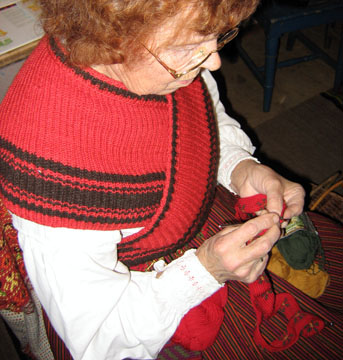
Tapestry crocheting in rounds the lower border of a sweater.
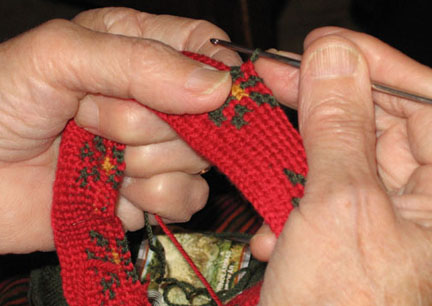
One color yarn rests on the front and the other on the back of the forefinger, while the other fingers grip them for proper tension.
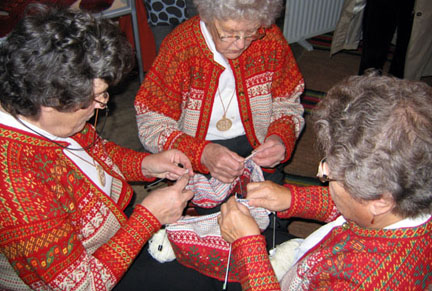
After the crocheted border has been finished, loops are pulled through the crochet stitches so that the body of the sweater may be knit in a tube, traditionally by more than one person at a time on double pointed needles.
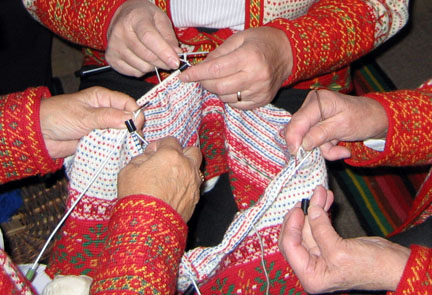
Each knitter completes one partial round, then it is rotated.
Another great place to see Korsnäs textiles is in private and museum collections. Since they are rarely able to exhibit everything, much of it is often in storage. If you make an appointment and are very lucky, though, a curator will let you into the “vaults” and allow photographs, too! Fortunately, luck was with me in Finland.
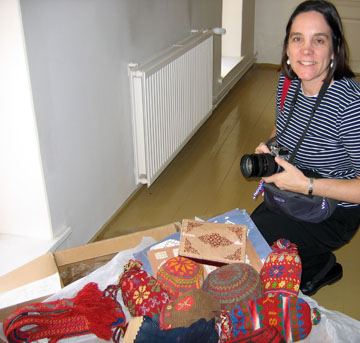
In the “vaults” of the Ostrobothnian Museum.
I suspect that Korsnäs tapestry crochet evolved from nalbinding, a much older looping technique that utilizes sewn loops. With tapestry crochet, only a small loop is pulled through with a hook, whereas with nalbinding, the entire yarn needs to be pulled through each loop with a sewing needle; very labor intensive. Even if the yarn is spun as needed, looping is still much more time consuming than crochet. Both techniques are still used to make mittens in Finland.
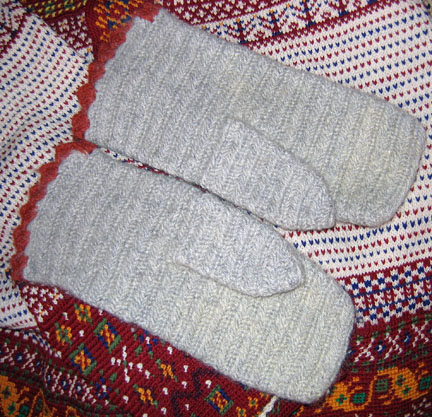
Nalbound mittens from the Karin Rosendahl collection.
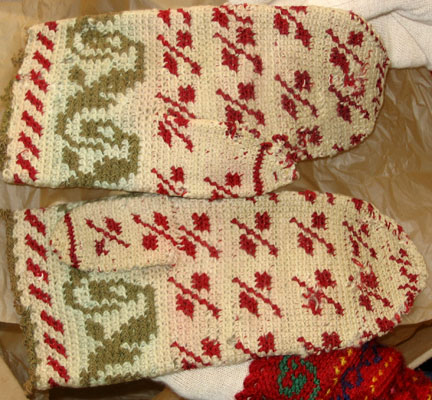
Tapestry crocheted Korsnäs mittens from the Ostrobothnian Museum.
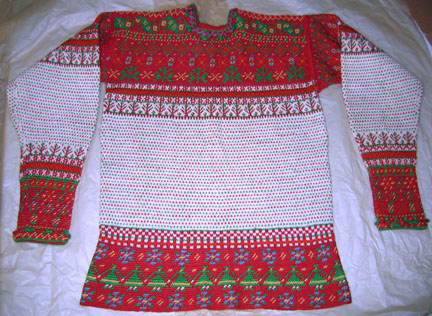
Korsnäs child’s sweater from the Ostrobothnian Museum.
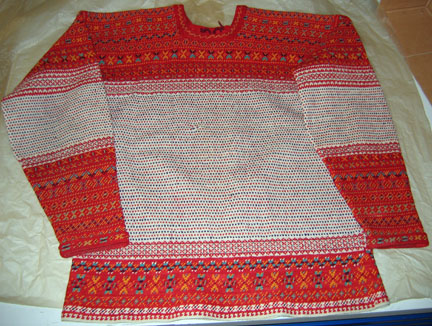
Korsnäs sweater from the Ostrobothnian Museum.
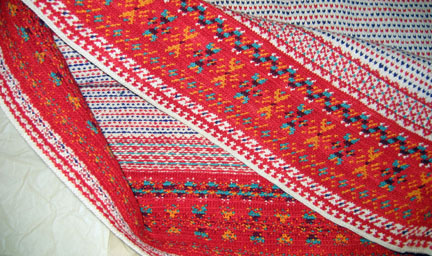
Detail of the lower part of the above sweater.
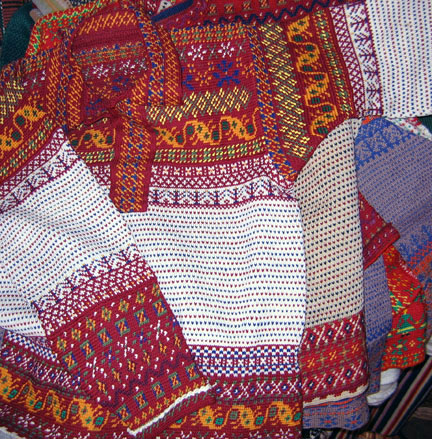
Korsnäs sweaters from the Karin Rosendahl collection.
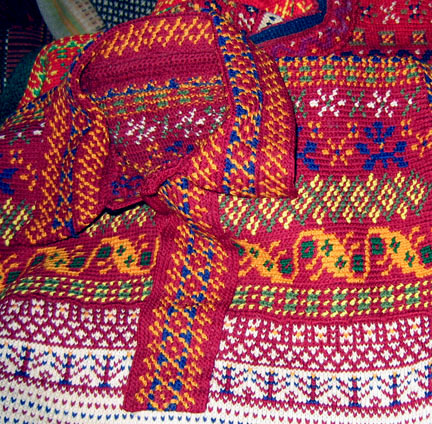
Collar detail of the above sweater from the Karin Rosendahl collection.
I will always be indebted to the many wonderful people who made this trip possible, especially Marketta Luutonen, Anna-Maija Bäckman, Leena Nyqvist, and Jeanette Rönnqvist-Aro.
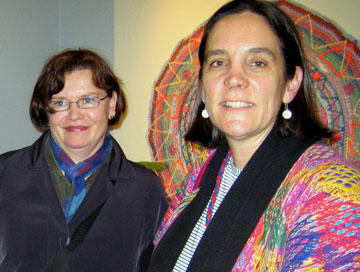
Marketta Luutonen and me.
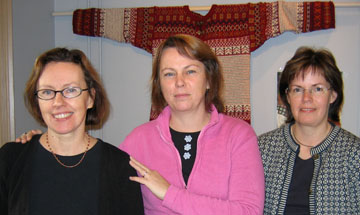
Anna-Maija, Leena, and Jeanette of Loftet.
Some of these names should now be familiar to you. Jeanette crocheted the cuffs in my previous post and Marketta and Anna-Maija have authored several excellent crochet publications. In fact, the best book (in Finnish, Swedish, and English) with history and patterns, is their Decorative Crocheting, which was printed in Vasa in 2003 (ISBN 951-96888-4-6). Marketta also wrote Virkattuja Pusseja (Crocheted Purses), printed in Vasa in 1992 (ISBN 952-90-4278-7). Although written in Finnish, it includes several excellent photos and graphs. Another good book is Korsnäströjor Förr Och Nu, by Gretel Dahlberg, printed in Vasa in 1987, ISBN 951-99832-4-4. Although not in English, it includes historical pictures, several museum pieces (many in color), and some graphs for sweaters and mittens.
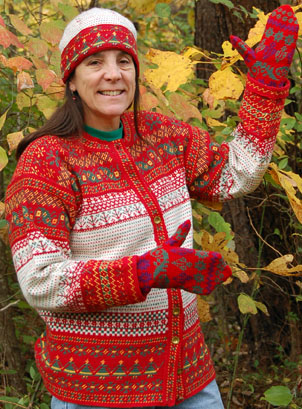
It took a year to get my ensemble, but it was worth the wait! Although I ordered mine at the Korsnäs Museum, it is also available online. I will be sure to wear it at the TKGA / CGOA Conference in Oakland in September. I hope to see you there!
I’m not sure how long it would take for them to make it – but mine took a year. They measured me at the museum and asked which motifs I wanted, and then I patiently waited. Loftet (see the link above) and the museum had some sweaters already finished, but they did not fit me. Expect to pay around $800 for a sweater. Considering all the work, I think it’s a bargain.
What beautiful designs with amazing detail. I thoroughly enjoyed reading your article. I was going to ask if you were able to purchase anything for yourself and your last photo answered that question. I saw the email contact – so I’m assuming it’s possible to order a sweater or one of the other items. How long does it take for them to make a sweater? Everything is absolutely beautiful. How lucky you are to have been able to see the museum and all these gorgeous fabrics.
This article was well worth the wait! I’m peering at the ladies knitting photo (it’s great!!!): are those black things needle stoppers? And are those dpn’s longer than the ones for socks, or am I imagining it?
I”ve been dreaming for months of my own pilgrimage to Korsnäs for the coming year. Among all the sweater-worshipping I intend to do, I hope to see the construction phase of a sweater and finally get my steeking questions answered. I’d also love to visit those other museums you mention. Would it be possible for you to post a list of them on your blog? Are the private collections open for public viewing? If so, could you post them too?
The sweater for which you show a detail of the inside…that’s the one I’m making! I’m almost finished the knitted section. And it certainly is worth more than 800$! I can well imagine it taking a year. Once I am back at work in September, I foresee it will take me about that long. If I hurry.
All my admiration to you Carol for this great work.
Danielle
Yes, the black things keep the stitches from falling off and the needles are indeed longer than the ones used to knit socks. You can find links to the Ostrobothnian Museum and Loftet in the captions above. I suggest you email them (English should be OK) about your interest and ask if you can visit. The fine women at Loftet arranged for the museum and private collection visits. Good luck with your sweater and with your trip and please let us know how it turns out!
I’m afraid I’m going to have to try to get one of those sweaters. I don’t think $800 is bad at all for the quality and workmanship that goes into these sweaters. They are absolutely gorgeous. I will try to contact them and see what I need to do. Thanks so much.
Since the value of the dollar has gone down in relation to the Euro since I bought my sweater, I’m not sure of the current prices. You will not only receive an heirloom item, but every purchase helps keep the craft alive! Please let us know how it works out.
There is no embroidery or beading on the Korsnas pieces. The pattern is achieved by changing yarn colors as they are crocheted.
it is so exciting! what about the embroidery on the crocheted part? what types are used? is it only for emphasis? how is it related to the design? is it more than just beading?
So cute work. Crochet is my passion. I would like to know how can I crochet. Is possible? Thanks .
Please look at my web page at https://www.tapestrycrochet.com/ for videos and information about how to tapestry crochet.
[…] https://www.tapestrycrochet.com/blog/?p=23 […]
[…] discover that I was not in fact the First Man on the Moon! Still later you posted your article on TC in Korsnäs and I went wild with delight over the photos, and wild with jealousy that you got to go […]
[…] an earlier blog that Korsnäs tapestry crochet might have evolved from nalbinding, an ancient looping technique. I believe the same thing […]
[…] explains, “I think I did my first tapestry crochet when I crocheted/knitted a Korsnäs sweater in the early 80’s. Since then I have crocheted a few (giggle) purses and bags (more giggle). Yes, […]
My family heritage is from Kornas Finland. I would love to have opportunity to purchase a Kornas Men’s Sweater. Please let me know if someone is available to make on for me.
Steve Westmark